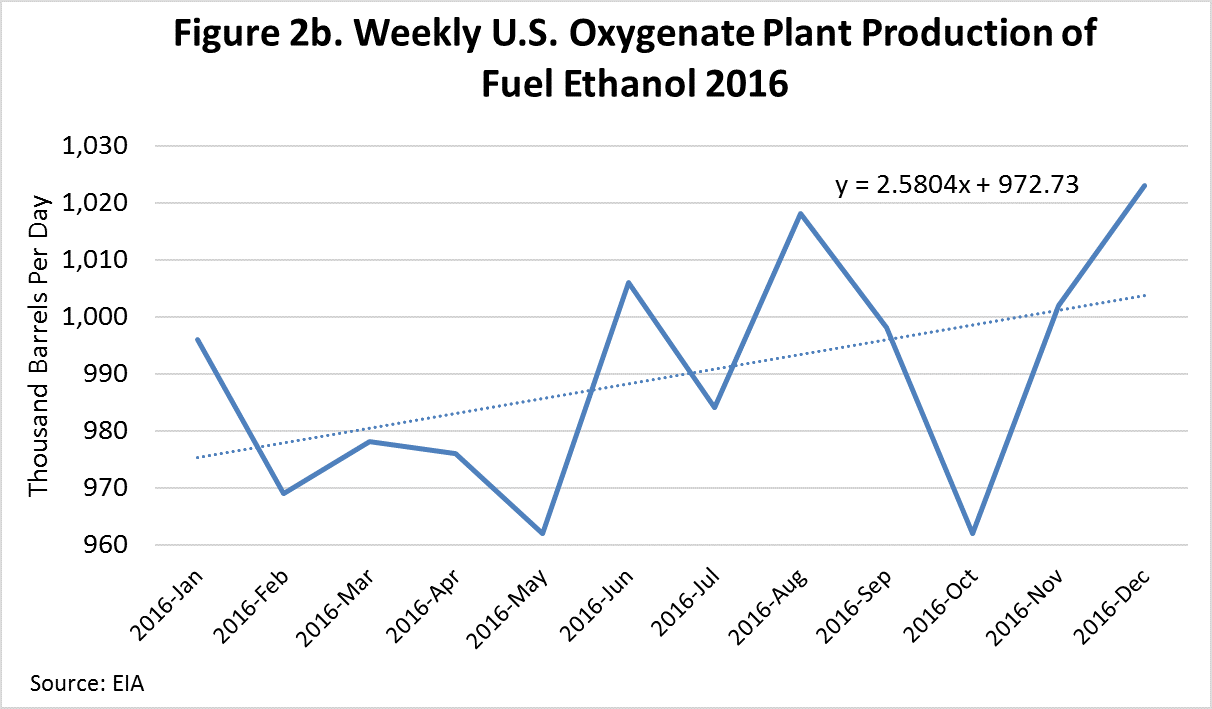U.S. Ethanol Price Decline in 2017: Historical Look at Possible Explanations
By Preston Lyman
Decision Innovation Solutions, 11107 Aurora Avenue, Urbandale, IA, 50322
January 2018
Ethanol Prices
The U.S. fuel ethanol markets have seen a progressively sharp monthly price decrease from September 2017 to December 2017. Average monthly ethanol rack prices fluctuated between $1.42 and $1.64 from January 2016 to August 2017. This stable trend ended in September 2017 as prices fell from $1.55 to $0.95 in December 2017, according to the Nebraska Ethanol Board. During the same period unleaded gasoline (87 Octane) rack prices, which are usually coincident with ethanol, diverged upwards between $1.82 in August 2017 to $1.99 in November 2017. This is the result of gasoline prices being bolstered by strong oil prices. These trends are illustrated in Figure 1.
 Ethanol Production
Ethanol Production
The growth rate of ethanol production decreased from 2,580 barrels per day in 2016 to 2,370 barrels per day in 2017. Although the growth rate has slowed by 210 barrels per day, ethanol production continues to grow by more than 2,000 barrels per day, on average. Nameplate fuel ethanol production plant capacity according to the Energy Information Administration was 1,011 million barrels per day, as of January 1, 2017.
 |
 |
Profitability
Operating margins have become increasingly tight in the latter half of 2017, falling from $0.46 per gallon in mid-September to $0.05 per gallon in mid-December (an 89% decrease in three months). As of January 5, 2018, these margins have risen slightly to $0.18 per gallon according to the Center for Agricultural and Rural Development at Iowa State University. These operating margins can be observed in Figure 3.

Corn Prices
During 2017 corn prices decreased at a rate of $0.02 per month, on average. (Figure 3). Corn is almost entirely the sole feedstock for ethanol production in the United States. However, USDA projections forecast ethanol to make up 35 percent of total corn use in the next 10 years, as compared to the 2012/13 marketing year peak of 42 percent.

Corn Production
As shown in Figure 5 corn production was 14.604 billion bushels in 2017, lower than 2016 by 544 million bushels. Ethanol prices decreased 38 percent (see Figure 1) over the last year, corn prices only decreased 0.4 percent (see Figure 4) and corn production decreased 4 percent. In the search for why ethanol prices have dropped so dramatically, corn production does not seem to be a major contributing factor. If corn supplies were to decrease there would be an increase in price (because of increased scarcity); however, if demand is lower than supply then price will continue to drop to push supply towards equilibrium. Furthermore, corn supply is influenced by multiple factors, two of which are ending stocks and exports.

Ending Stocks
Ethanol ending stocks* are generally higher at the beginning of the year and decrease incrementally throughout the year. Ending stocks in 2017, compared to the five-year-average, were 14% higher, on average throughout the year. These 2017 ending stock trends coincide with trade data where exports decreased between September to October 2017. Decreased exports likely contributed to increased supply (ending stocks). Ending stock trends are observable in Figure 6, exports are in Figure 7.

Ethanol Exports
As illustrated in Figure 7 ethanol export volumes have experienced several sharp increases since January 2010 with the primary destinations being Brazil and Canada. Ethanol exports to Brazil were at 42,027 liters (11,115 gallons) in January of 2011, and rose to 292 million liters (77 million gallons) by December of 2011, after which they fell again to zero liters in November 2012. Ethanol exports to Canada are much less volatile with 2014 exports rising 60 million liters (15 million gallons) over the course of five months (63 million liters (16 million gallons) in February 2014 to 123 million liters (32 million gallons) in July 2014).
From 2015-2017, exports to Brazil increased saw a similarly sharp spike from zero liters in October 2015 to 243 million liters (64 million gallons) in May of 2017 and then back down to 48 million liters (12 million gallons) in October 2017. Corresponding to these trade fluctuations are similar fluctuations in U.S. ethanol prices during and after the surges. This relationship is indicative of exports playing a role in ethanol price, although other domestic and international contributing factors are certainly at play.

Conclusion
From the categories analyzed in this article (unleaded gasoline prices, ethanol production, ethanol prices, corn prices and production, ethanol ending stocks and ethanol exports) the two categories with the most influence on ethanol price are exports and ending stocks. Both show trends that may explain some of the ethanol price fluctuations of the last year. The influence of ethanol export markets on the price of ethanol will likely continue to increase and will impact profit margins for ethanol production in the coming years.
Recommended Citation
Lyman, Preston L. 2018. “U.S. Ethanol Price Decline in 2017: Historical Look at Possible Explanations” Renewable Energy Report, Agricultural Marketing Resource Center, Iowa State University. January.
*Stocks include those domestic and Customs-cleared foreign stocks held at, or in transit to, refineries and bulk terminals, and stocks in pipelines. Stocks held at natural gas processing plants are included in "Other Oils" and in totals. All stock levels are as of the end of the period. Data may not add to total due to independent rounding. Weekly data for RBOB with Ether, RBOB with Alcohol, and Reformulated GTAB Motor Gasoline Blending Components are discontinued as of the week ending June 4, 2010 reporting period. Monthly data for RBOB with Ether, RBOB with Alcohol, and Reformulated GTAB Motor Gasoline Blending Components are discontinued as of the January 2010 reporting period. Beginning with data for January 2005 total crude oil and petroleum products stocks do not include lease stocks. See Definitions, Sources, and Notes link above for more information on this table. (https://www.eia.gov/dnav/pet/PET_STOC_WSTK_A_EPOOXE_SAE_MBBL_W.htm)



